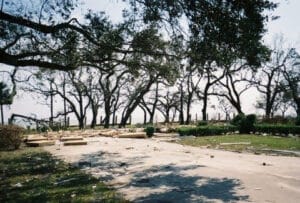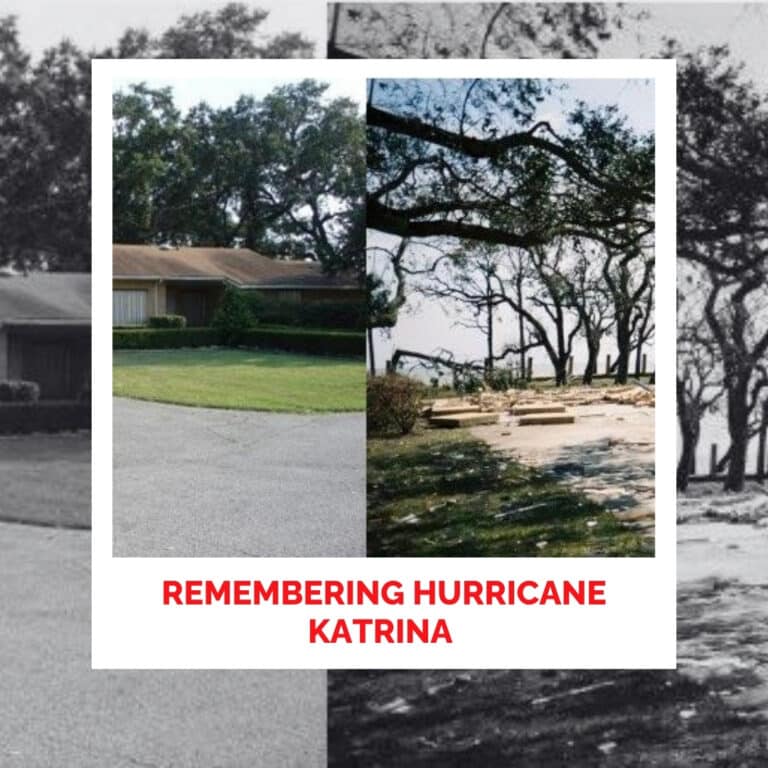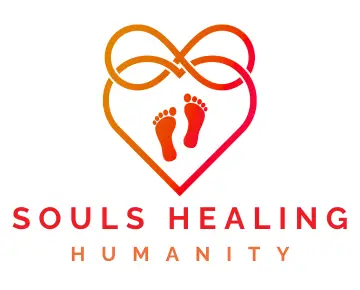The Best and Worst Day of My Life
This true story of surviving Hurricane Katrina offers trauma-informed insight for anyone stripped bare by suffering and ready to rebuild from their True Self.What This Post Is Really About: TL;DR: Katrina stripped me down to nothing—and that’s where I found everything.
Twenty years ago, I thought I was about to reinvent myself. We had just left gray, soul-sucking Michigan, where depression and Seasonal Affective Disorder had been eating me alive. My then-husband had accepted a CEO role at a military retirement community in Gulfport, Mississippi, and I had big plans: step away from work, focus on my doctorate, and finally build the life I thought I deserved. My ego was massive. I didn’t realize it then, but I was bloated with illusions of control, certainty, and self-importance. Two weeks later, Hurricane Katrina stripped some of it away.The Day the Storm Came
On August 29, 2005, Katrina made landfall in Gulfport/Biloxi. We were told not to evacuate, but to shelter in place with 450 senior citizens in a high-rise supposedly built to withstand hurricanes. That choice would haunt me for years. At first, it felt almost casual. People joked about riding it out, treating it like a hurricane party. My thirteen-year-old daughter, Kirsten, was down the hall with other kids watching movies and giggling. But by morning, we all knew this wasn’t a party. Water started pouring in on the first floor. I sat in the security office, talking with guards when a young officer burst in: “Sir, we need more sandbags.” The response: “Sorry son, there are no sandbags left.” That’s when everything shifted. Glass doors shattered. Water rushed in like a freight train. Soldiers and staff scrambled to haul men and women in wheelchairs up flights of stairs. The entire first floor became a river. My husband gave the order to evacuate everyone to higher levels. And me? I was on a stairwell with Kirsten and our dog, Molly, shaking so hard I thought my bones might break. I told my daughter words no mother should ever have to say: “We may die today, but if we do, we’ll die helping others.” She looked up at me with that freckly little face and auburn hair, trusting that her mother would keep her safe. She was scared, and I remember the hollow ache of knowing everything was out of control — and that I could not keep her safe.The Terror and the Miracle
Molly had been left in my husband’s office earlier — a decision I hated but didn’t have the courage to fight. When the walls started collapsing, I panicked. We ran toward the office, only to see young soldiers literally holding up a buckling wall with their shoulders so we could get down the hallway. We grabbed Molly and sprinted out. That dog saved me as much as I saved her. See, Molly was a jumper. She launched herself on anyone, everyone. I had never been able to break her of the habit. But that day, she transformed. As Kirsten and I carried water to terrified residents, Molly became a therapy dog. She sat calmly, letting frail old hands stroke her fur while they reminisced about the pets they once had. She never jumped again — not that day, not ever. Katrina gave Molly her wings. Watching her, I realized she wasn’t the only one being remade.The Surreal Hours
Time warped. My watch said 9:15 AM, but it felt like hours had passed. Explosions shook the building as windows blew out. An elderly Southern woman sat beside me and whispered, “Sweetheart, these buildings are built to breathe.” I thought she was crazy. Now I understand — the walls were flexing like lungs, alive and groaning under the force of the storm. When the eye of the storm passed overhead, the world transformed. The sun pierced through the ragged clouds, and for a fleeting moment the sky looked innocent, almost calm—as if the violence had been a bad dream. But the silence was cruel. From the windows we caught our first glimpse of the devastation: trees snapped like twigs, power lines down, water swallowing everything in sight. The sight was gut-wrenching. And then—like a sick joke—the second half roared in. The winds howled with even more fury, battering the building for hours that felt like a lifetime. Each gust shook the walls, each wave of rain slammed against the glass as if the storm itself was determined to break through. By the evening of August 29, Katrina finally began to loosen her grip, drifting on and leaving behind wreckage in her wake. But even in retreat, danger lingered. Just outside, an 8,000-gallon diesel tank threatened to collapse toward the very building that sheltered us. We didn’t know then that the floodwaters had already drained it empty, leaving it unstable and ready to topple. When it finally gave way, by some miracle, it fell in the opposite direction—sparing us. When night finally came, we collapsed in the hallway, pretending to sleep. At dawn, I walked outside and saw a pelican standing in the wreckage of the lobby, its wide eyes stunned, dazed, lost. That bird was me. That bird was all of us. Later, we walked to what was once our home.

The Aftermath
The next day, the building became toxic. The stench of sewage, and rot filled the air. Bugs swarmed. FEMA? Nowhere. It felt as if we were abandoned. There are only two U.S. Armed Forces Retirement Homes in the country—one in Gulfport, Mississippi, and the other in Washington, D.C. When Katrina hit, the only reason we got help at all was because of a freak stroke of luck: our cell phones somehow still worked. Everyone else’s had gone dead, but ours managed to catch a signal from an old Michigan provider. It felt like holding the last lifeline left in a drowning city. Hour after hour, my then-husband and I continued to frantically call Washington,, D.C. We begged anyone who would listen to understand the sheer scale of the catastrophe. We weren’t talking about minor damage or a temporary inconvenience—we were talking about hundreds of vulnerable senior residents stranded in a disaster zone with no way out. We pleaded for buses, for rescue, for someone in power to realize this wasn’t a situation we could survive much longer without help. Finally they listened but didn’t arrive until nearly midnight on August 30. We loaded 450 exhausted, traumatized residents onto buses bound for D.C. As we drove north, we passed a caravan of FEMA vehicles. I’ll never forget the bile in my throat as I thought: you f*ckers are too damn late. And then, at a McDonald’s in Virginia, the absurdity peaked. I told the manager the U.S. government would pay for food. The military man from the Gulfport facilty who was “in charge” — let’s call him Mr. McMurphy — screamed at me for overstepping. Policies. Protocols. Authorizations. I snapped. I slammed my credit card on the counter and shouted, “Then I’ll f*cking pay for everyone.” It became the infamous No McMuffin Murphy Story. It also branded a truth into me: policies will always try to override people. And if you let them, they’ll kill your humanity. After staying with family in Virginia for a few months following Katrina, we ultimately ended up moving back to Michigan. The Multiverse had more incredible lessons for me to learn.The Weight of Guilt and Shame
For years after Katrina, I carried a heavy, invisible anchor. I told myself that my depression, my illness, my weakness had put my family in harm’s way. If I had been stronger, healthier, “better,” maybe we wouldn’t have ended up in Gulfport at all. That guilt and shame became weapons I used against myself. Every time I stumbled, every time I doubted, I replayed the story: See? You’re unworthy. You’re the problem. You put everyone at risk. But here’s the Truth Biscuit that smacked me awake: that whole story about me being unworthy and f*cked up? Pure, unfiltered bullsh*t. It wasn’t until I began using Holistic Scaffolding™ that I could finally sit with all of me — the broken parts, the shadowy parts, the parts I thought were “weak.” I learned to accept them, to even celebrate them. Because not only did I survive Katrina — I thrived because of it. That storm stripped me bare, but it also revealed a strength I didn’t know I had. It showed me that being unwell didn’t make me unworthy. It made me human. And it was through honoring all of me that I found my way back to alignment with my True Self.The Lessons Katrina Branded on My Bones
For years, I carried the bitterness — at FEMA, at State Farm (who refused to cover our supposedly insured losses), at Capital One (who denied extending credit because we lived in a disaster zone). It almost drowned me long after the water receded. While the insurance shysters found every loophole imaginable to avoid covering our physical losses, I knew we would ultimately be fine. But it hurt my heart knowing so many others would not. Families who had already lost everything were about to be f*cked over again — dragged through years of unfair denials, lawsuits, and hardship. That cruelty was almost harder to stomach than my own losses. But here’s what I know now: Things don’t matter. People do. Ego is dead weight. Let the storm strip it. Bitterness is just another storm that keeps you stuck. Service to others will pull you out of despair faster than self-pity ever will. And the Mystery? The Mystery doesn’t give a damn about your plans. It will gut them to wake you the f*ck up. For years I said, “Katrina was the best and worst thing that ever happened to me.” That paradox is still true. It was terrifying, devastating, and cruel. And yet it was the most beautiful gift: the day I started to learn what alignment really meant. I want to be clear: I did not “build” all six platforms of Holistic Scaffolding™. They were gifted to me by the Multiverse as I unpacked layer after layer of generational trauma, bullsh*t programming, and conditioning. I may be the one who received it, but it isn’t mine. It was never meant for just me. It belongs to humanity.*The Truth Biscuit
You don’t choose the storm. But you do choose how it defines you. You can cling to anger, rage at the bullsh*t systems, and drown in your own bitterness. Or you can let the storm strip you bare, show you what actually matters, and rebuild on a foundation of alignment. Katrina was the worst day of my life. And the best. Because it gave me wings too.✨ Now it’s your turn: What storm in your life felt like it was sent to destroy you — but ended up stripping you into your True Self?
Please comment below. I love all you people. Love and ((HUGS)), LauraIf you’re walking through your own storm, you’re not alone. Explore: Best Fit Briefs · Why Souls Healing Humanity Is Different · FUNFU — Fed Up, Not F*cked Up If you want “Back to top” after each major section, just drop: Back to top


